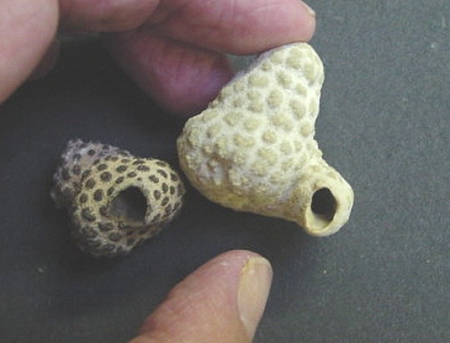Data:
The attached was found by me in a bunch of dredged shells in Amuay, Paraguana
Peninsula, Venezuela last month.
I hope the size can be determined from my fingers. Thanks, Ron in Olympia.
Send thoughts and
ideas to:
Email: Ron

Identification: "Texas Longhorn", phylum Bryozoa, genus Hippoporidra, species ?? For an interesting article go to one of the Jacksonville Shells Club's Page at: http://www.jaxshells.org/jdawley.htm
Discussions:
-
That seems to be a sponge (phylum Porifera), but i don´t know it...
Wiggers, from sunny Brazil -
Those look like a species of Hippoporidra, a bryozoan colony that builds its structure on a small gastropod shell. The shell is often then inhabited by a hermit crab...Tom E.
-
I agree with Tom. -A congener has a somewhat different "shell" topology, and is more familiar to Florida and other Gulf of Mexico offshore collectors. The late June Dawley wrote a short paper on that species, the "Texas Longhorn;" and its symbiont. The article is posted at: http://www.jaxshells.org/jdawley.htm ...Harry L.
-
This was fairly common in beach drift on Margarita Island during my Labor
Day w/e trip. Looks like Olivella minuta is a frequent foundation for this
colony...David K. -
Hey all;- I have seen (collected) several Olive shells in South Carolina with just such Bryozoan colonies attached. They can generally be removed in one piece. I haven't found any of them inhabited by crabs. Perhaps it is because the Olives are too heavy for their siize for the crab to move in comfortably. I suppose the colonies would also grow on whelks---but I haven't noticed.
Art W. -
This is definitely a hermitcrab-associate bryozoan. The same genus (and probably species) occurs in NZ, and I have dredged them.
The colony starts on a shell inhabited by a crab, and overgrows the aperture, producing a tube...Andrew G.